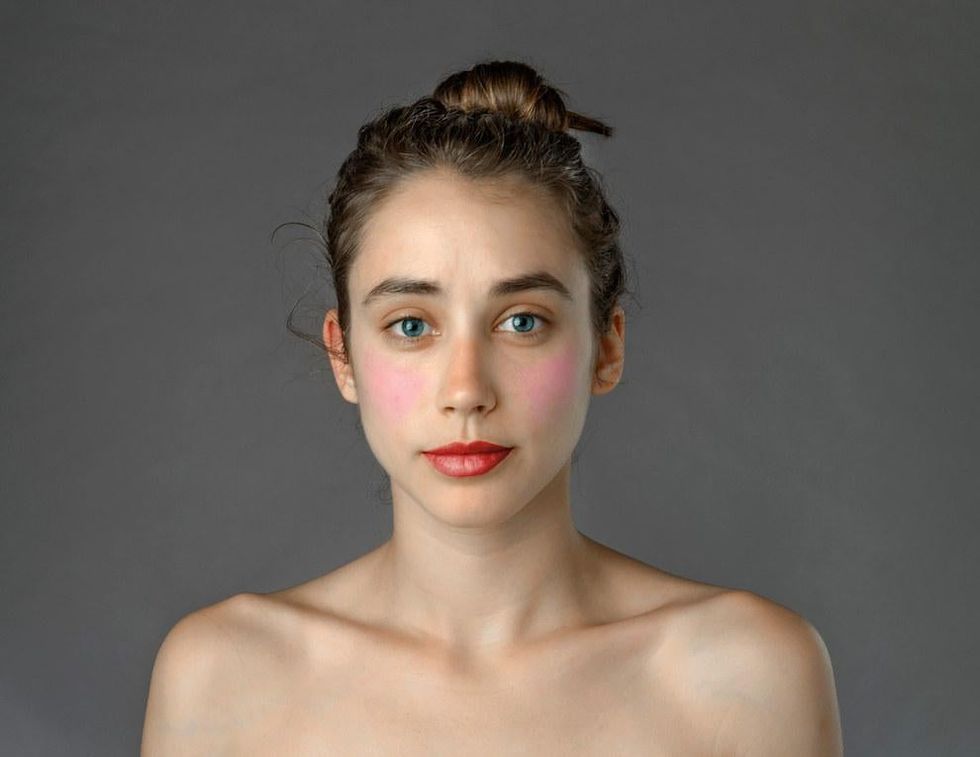News
Harriet Marsden
Oct 21, 2016

Picture:
indy100/composite
You may not remember her name, but you'll certainly remember her face.
Esther Honig sent this picture of herself to Photoshop editors around the world, and asked them to adjust her face according to their standards of beauty.
She released the results in a photoseries entitled Before & After, which initially went viral in June 2014.
People attributed various aims and meanings to the photoseries: she was making a point about subjective beauty; she was battling stereotypes; she was denouncing PhotoShop; it was about feminism, unattainable standards of beauty...
indy100 spoke with Esther to find out what her project was really about, and how it felt for her face to go viral and to become recognisable across the internet.
Behind the scenes
I started this project because I thought it was a good way of illustrating the different beauty standards that exist across the world. Over the years, in my travels and studies, this concept has always interested me and thought this would be a creative way to explore that.
She was also "incredibly broke" at the time, fresh out of college, and took a big financial risk feeding hundreds of dollars into this idea "that could potentially flop": "I figured that worst case scenario, I'm down a good chunk of money. But I was never reluctant to see the project through."
According to Esther, she asked the editors to use PhotoShop in whatever way necessary to "make me beautiful".
"A few of them were very hesitant to make any drastic changes - I think maybe they thought I would be offended?"
Some even asked for an example of an image, of a person she wanted to look like. Again, she had to insist on their creative free reign.
Taking shape
But once she started to receive the images back, "the project became exciting".
"Opening each email from a photo editor was this big reveal. It felt like I was peering into the minds of these strangers halfway across the word to see how they'd reimagined me. My project was taking shape and that was incredibly gratifying."
But, Esther says, the results did not support her original hypothesis.
About halfway through I thought the project had failed. I had assumed these images would somehow reflect the predominant beautify standards inherent to the country where the photo editor was based. But that wasn't the case.
She feared people wouldn't take the time to try and interpret the subtle nuance of the images, because there was no easy way to explain why each photo looked the way it did.
Going viral
But she decided that the project was at least interesting, so she pitched it to BuzzFeed and they were immediately onboard.
"When it started to go viral, it was exciting but almost immediately horrifying and gut wrenching. I knew I had put myself out there in a way I could not easily walk away from; this was my face and it was exploding across the internet."
According to Esther, a girl who used to get nervous speaking up in class, and had "severe anxiety around presentations", suddenly without preparation she found herself thrust onto live international TV interviews, for the likes of CNN and Al Jazeera.
Every hour I had thousands of emails and interview requests pouring into my inbox. It was a once in a lifetime opportunity and it all depended on how quickly I could respond to these interviews, and how well I could talk about this project.
It was like that nightmare where you're back in college and you show up to take your finals exam, only you realize you haven't studied or come to class all semester. Within the first 24 hours my adrenal glands were completely shot, but that onslaught of mass attention continued for another two weeks.
Don't feed the trolls
According to Esther, her work was used without permission, permeating every corner of the internet, and she faced criticism from both serious sources and trolls.
"I found thoughtful feedback from the people and minds that I value, but there are many more internet trolls than I had time to consider. Criticism is an important step in creating anything, but the comments section is rarely an opportunity to pick up on constructive feedback."
She eventually began to despise the attention, but decided to write about the experience for Pelican Bomb magazine, for the 'virality' issue.

Looking forward
She tells the indy100 that, although creative people have used social media to develop some "brilliant projects", there's also "a lot of garbage out there".
"There's hoaxy articles, and images and video that exploit others. The internet is a hungry machine that spits content forward indiscriminately. I think it's our responsibility as consumers to select the content that challenges our intellect, and to ignore the junk that's pulling us in circles."
But Esther has found a positive outcome from the whole experience. "Being creative in any capacity means taking a new idea and throwing it at the wall to see what sticks. Then you learn what worked and move on."
I've grown a thicker skin and I'm incredibly thankful for that. Like many young women, I had the tendency to internalize negative criticism. I had this paralysing fear that I would do something dumb or naive. I've learned that regardless of if you mess up or get it right, everyone's talking about something else the next day.
More: What being beautiful means in 25 countries around the world
More: This artist has created illustrations of mental illnesses for #Inktober
Top 100
The Conversation (0)



















